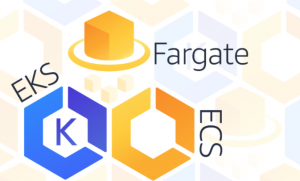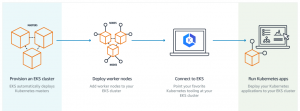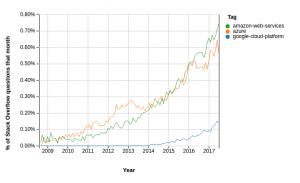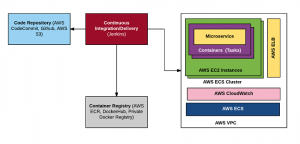Category Archives: AWS
AWS Cloud9 IDE and Java / PHP Hello World

This article represents tutorial in relation to how to get started with creating your first Java / PHP Hello World program using AWS Cloud9 IDE. Supported Runtimes in AWS Cloud9 Before getting started with creating runtime environment and execute hello world programs in Java and PHP and other languages, lets look at what all runtimes are supported. Following screenshot represents the supported runtime: The above represents the fact that one could create programs / application using one of the following programming languages: C C++ Java Go Node.js PHP Python Ruby In this article, I have shown how to create hello world program using Java and PHP programming language. The following steps represent way to create your hello world programs. The following are some of the steps …
Why use AWS Fargate for Deploying Your Cloud-Native Apps

In past, if you have been used to deploying your cloud-native apps or microservices hosted within a Docker container on AWS ECS, you may have also been required to do some of the following: Choose server types in relation with provisioning AWS EC2 instances Configure appropriately to scale the cluster as and when required Optimize cluster packing In short, with AWS ECS, until the launch of AWS Fargate, you were required to manage the infrastructure and related configuration in relation with scalability etc. With AWS Fargate, Focus in on Designing and Building Apps With AWS Fargate, all that is required to be done are some of the following: Package your application in containers Specify the CPU and memory requirements Define …
AWS EKS is the Way to Run Kubernetes on AWS ECS

AWS Elastic Container Service for Kubernetes, AWS EKS, is a new AWS fully managed service running Kubernetes out-of-box on AWS without needing to install and operate / manage our own Kubernetes clusters. . Gone are the days when we (63% of Kubernetes workloads as per CNCF spent time and effort setting up and running / managing Kubernetes (Master and a cluster of workers) on AWS EC2 instances with no support from AWS service. Not only this, there was whole lot of high availability requirements in relation with Kubernetes which needed to be managed by running Kubernetes master on different availability zones (AZs). Key Features of AWS EKS Support for existing plugins and …
AWS Architects – Best Practices to build Efficient Systems

Here is a great resource (best practices and guidelines) which would help cloud architects (especially, AWS Solution architects) build the most secure, high-performing, resilient, and efficient infrastructure possible for their applications. That said, these cloud architecture whitepapers (pdf) would also prove helpful and useful for all kinds of cloud architects including Azure, Google Cloud, IBM, Oracle cloud etc. The following lists down the links for pages in related areas of interest: Operational excellence: Includes topics such as managing and automating changes, responding to events, and defining standards to successfully manage daily operations. Security: Includes aspects such as confidentiality and integrity of data, access-control, data audit etc Reliability: Includes topics such as recovery …
Cloud Platform Trends (Oct 2017) – AWS Wins

This blog represents the cloud platform trends for the month of Octobar 2017 with primary focus on AWS, Azure and Google Cloud platforms. The clear winner is AWS. Indeed.com Job Postings Trends Following represents job posting trends on the popular portal, indeed.com: Google.com Search Trends The following represents Google search trends for cloud platforms: StackOverflow Q&A Trends The following represents Stackoverflow Q&A trends for cloud platforms:
MongoDB – Top 10 Best Practices for AWS Production Deployments
The following are some of the best practices which should be considered for your MongoDB production deployments on AWS. File system: MongoDB recommends using either of XFS or EXT4 filesystem for greater performance. With WiredTiger storage engine, it is strongly recommended to go with XFS file system. Refer this page, MongoDB production notes for finer details. AWS EBS (Elastic Block Store) Configuration EBS-optimized instances: It is advisable to use EBS optimized instances to host MongoDB database. With EBS optimized instances, there are separate network interfaces for database, and, other traffic (application traffic). In case, the replica set is configured with ephemeral storage, at least one of the secondaries in the …
Configure Bitbucket Webhook to Trigger Jenkins Builds on AWS EC2
This article represents steps required to configure BitBucket Webhook to trigger Jenkins Builds on AWS EC2 based on code committed in the repository. This essentially means that a code commit in the BitBucket code repository would trigger a build in Jenkins server running on AWS EC2 machine. This forms the starting point of continuous delivery pipeline. The jenkins build, when triggered as a result of code push, could perform tasks such as some of the following: Run the build, Run tests Publish build artifacts in artifactory Deploying the build artifacts in different environments including QA, UAT and production. Please feel free to comment/suggest if I missed to mention one or …
Microservices, Continuous Delivery & AWS Cloud – Part 1

This article represents details on how would the technology architecture look like when dealing with continuous delivery of microservices containers (Dockers) on AWS Cloud. Please feel free to comment/suggest if I missed to mention one or more important points. Also, sorry for the typos. Following are the key points which will be dealt with, in this and the following article (part 2): Technology architecture building blocks Technology architecture description Technology team and required skillsets In this article, we shall look into key technology architecture building blocks. In second part of the series, we shall look into steps needed to be configured to achieve the continuous delivery of microservices containers into AWS cloud …
I found it very helpful. However the differences are not too understandable for me